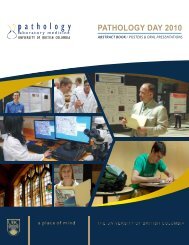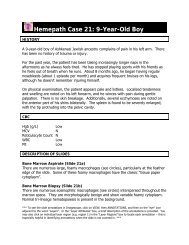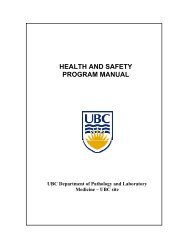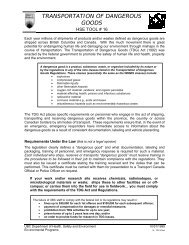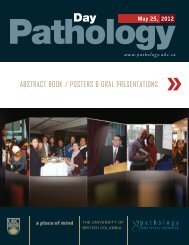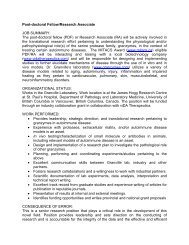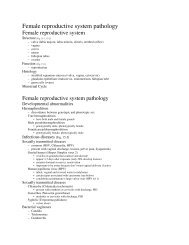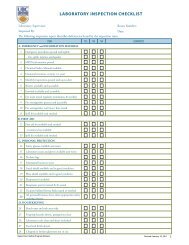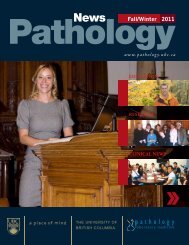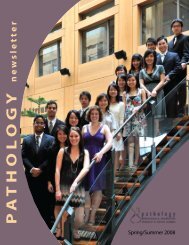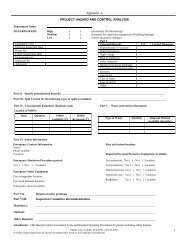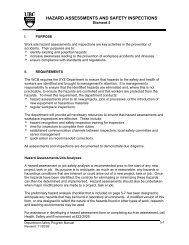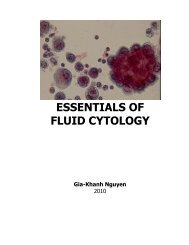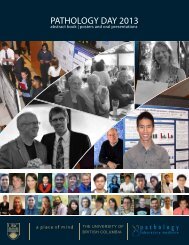Department bids farewell - Pathology and Laboratory Medicine
Department bids farewell - Pathology and Laboratory Medicine
Department bids farewell - Pathology and Laboratory Medicine
You also want an ePaper? Increase the reach of your titles
YUMPU automatically turns print PDFs into web optimized ePapers that Google loves.
PATHOLOGY<br />
U n i v e r s i t y o f B r i t i s h C o l u m b i a<br />
<strong>Department</strong> <strong>bids</strong> <strong>farewell</strong><br />
to Prof. Hegele<br />
news<br />
FALL/WINTER 2008-09
In early December the <strong>Department</strong> hosted a party to honour <strong>and</strong> thank Dr. Richard<br />
Hegele for his nineteen years of service at UBC. On January 1, 2009 Dr. Richard<br />
Hegele assumed the position of the Head of the <strong>Department</strong> of <strong>Pathology</strong>, University<br />
of Toronto.<br />
We wish Dr. Hegele the very best in his new role.
Fall/Winter 08-09 CONTENT<br />
1 Overview<br />
From The <strong>Department</strong> Head . 3<br />
New Faces . 4<br />
PathDay Annual Conference. 8<br />
R u d d e l e n i t i n h e n i s i m v e l i s s e q u i s i e xe r s i s e l e s e<br />
m o l o r e d u n t a d d i o e u f e u f e u m s a n d i p s u s c i p s u m<br />
iriure delismo dolent vero erit enim velissisisi bla<br />
2 Research Environment<br />
EDITORS:<br />
Maureen Barfoot<br />
Debbie Bertanjoli<br />
PUBLISHER: Debbie Bertanjoli<br />
Email:<br />
Dr. Wellington <strong>Laboratory</strong> . 9<br />
New Translational Research Building. 10<br />
Associate Vice President Research at UBC . 12<br />
BCCA Annual Conference . . . . . . . . . . . 13<br />
2 Academic activities<br />
AP Residency Program . 14<br />
Graduate Programs. 15<br />
Where Are They Now . 16<br />
<strong>Pathology</strong> Summer Student Research Program . 19<br />
3 Meet the people of pathology / creative interests<br />
An Inspiring Philanthropist <strong>and</strong> Volunteer . . . 20<br />
Faculty on Spot. 22<br />
On my 2008 year . 24<br />
Volunteer Abroad . 26<br />
What’s New with the BC BioLibrary . 27<br />
dbertanjoli@pathology.ubc.ca<br />
C u r r e n t a n d b a c k i s s u e o f N e w s l e t t e r<br />
can be found on the <strong>Department</strong>al<br />
Website: http://pathology.ubc.ca<br />
Richard Hegele, MD, FRCPC, PhD<br />
As I prepare to begin my new position at the University of Toronto, I would like<br />
to thank all of you who have expressed such kind words <strong>and</strong> good wishes. For<br />
this message, rather than providing a laundry list of accomplishments (<strong>and</strong><br />
things still to do) during my time as Head of the UBC <strong>Department</strong> of <strong>Pathology</strong> <strong>and</strong><br />
<strong>Laboratory</strong> <strong>Medicine</strong>, I would like to use this opportunity to reflect on some key aspects<br />
of our <strong>Department</strong> that make us well positioned to meet future challenges as a thriving<br />
academic unit. One cannot help but be impressed by the diversity of the <strong>Department</strong>:<br />
there is virtually no area in our research <strong>and</strong> education portfolios that does not have<br />
a shining example of innovation <strong>and</strong> leadership locally, provincially, nationally <strong>and</strong><br />
internationally. At the risk of degenerating into cliché, it truly is the people of the<br />
<strong>Department</strong>, at all levels <strong>and</strong> types of activity, who allow this to happen. There are of<br />
course two sides to this coin: with such diversity, issues like communication to such a<br />
wide range of interests across multiple locations, <strong>and</strong> promoting a sense of belonging<br />
within our academic home can be very challenging. From my perspective, if one is<br />
able to experience ongoing personal <strong>and</strong> professional growth from being part of the<br />
<strong>Department</strong>, then the <strong>Department</strong> is doing its job.<br />
A second point I would like to emphasize is the role of our students <strong>and</strong> trainees. Instead<br />
of being considered the “future” of our discipline, they are part of the here <strong>and</strong> now.<br />
“it is our students <strong>and</strong> trainees that distinguish the<br />
academy from industry, or institutions that focus<br />
exclusively on health care delivery.”<br />
This reality means academic activity cannot hope to achieve the various “efficiencies”<br />
of these other types of organizations (although there is always room for improvement).<br />
In this age of ever-increasing accountability (read: measurement), it behooves us to use<br />
more appropriate measures of effective outcomes of the academic mission in our complex<br />
system <strong>and</strong> make people underst<strong>and</strong> them.<br />
Finally, please be reminded that the academic mission is broadly categorized into<br />
education, research <strong>and</strong> service. Concerning the latter, it is through members<br />
participating constructively in the affairs of the <strong>Department</strong> that will ensure its ongoing<br />
vitality <strong>and</strong> relevance.<br />
It has been a privilege for me to work with you <strong>and</strong> I will continue to follow<br />
developments of the UBC <strong>Department</strong> of <strong>Pathology</strong> <strong>and</strong> <strong>Laboratory</strong> <strong>Medicine</strong> with great<br />
interest. Best wishes for 2009.<br />
THE PATHOLOGY NEWSLETTER<br />
3
Through knowledge, creating health.<br />
Head, <strong>Department</strong> of <strong>Pathology</strong> <strong>and</strong> <strong>Laboratory</strong> <strong>Medicine</strong><br />
<br />
<br />
<br />
<br />
<br />
<br />
<br />
<br />
<br />
<br />
<br />
<br />
<br />
<br />
<br />
<br />
<br />
<br />
<br />
<br />
<br />
<br />
<strong>Department</strong> of <strong>Pathology</strong> & <strong>Laboratory</strong> <strong>Medicine</strong><br />
www.med.ubc.ca<br />
<br />
<br />
<br />
<br />
Gavin C.E. Stuart, MD, FRCSC<br />
Dean, Faculty of <strong>Medicine</strong><br />
University of British Columbia<br />
c/o Joan Gray<br />
#317-2194 Health Sciences Mall,<br />
Vancouver, BC V6T 1Z3<br />
searches@medd.med.ubc.ca<br />
<strong>Pathology</strong> Head<br />
<br />
<br />
<br />
<br />
<br />
<br />
<br />
<br />
<br />
<br />
<br />
the uniVerSitY oF BritiSh ColuMBia<br />
UBC hires on the basis of merit <strong>and</strong> is committed to employment equity. We encourage all qualified applicants<br />
to apply; however, Canadians <strong>and</strong> permanent residents of Canada will be given priority.<br />
www.ubc.ca & www.med.ubc.ca
Welcome New<br />
Faculty<br />
Members<br />
Fall/Winter 2008-09<br />
Dr. Cooper received her undergraduate degree (BSc) from the University of Regina where she<br />
majored in biology. From there she moved to Vancouver to complete a Masters in Disease Ecology<br />
at the University of British Columbia. During her MSc, she developed an interest in parasitology<br />
<strong>and</strong> vector-borne diseases. With these interests in mind, she moved to Simon Fraser University to<br />
complete a PhD under Dr. Carl Lowenberger, where she focused her research on apoptosis <strong>and</strong><br />
the antiviral immune response using Dengue virus <strong>and</strong> the yellow fever mosquito as her model<br />
system. Dr. Coper’s academic interests include the evolution of cell death pathways, apoptosis<br />
<strong>and</strong> immunity (antiviral <strong>and</strong> anti-parasitic), <strong>and</strong> the role of cell death in disease pathogenesis. In<br />
August 2008 she joined Dr. David Granville’s group to work on mechanisms of cell death <strong>and</strong><br />
their roles in cardiovascular disease. In addition to research, she enjoys teaching <strong>and</strong> working with<br />
graduate students.<br />
DAWN COOPER<br />
Postdoctoral<br />
Research Fellow<br />
Heart <strong>and</strong> Lung<br />
Institute, James Hogg<br />
iCAPTURE centre, St.<br />
Paul’s Hospital, UBC<br />
Born <strong>and</strong> raised in Edmonton, Alberta, Dr. Dunham received his BSc in Science Psychology at<br />
the U of Alberta after which he obtained his MD from the U of Ottawa in 2001. His interest<br />
in Neuropathology was peaked by an early mentor, Dr. Vital Montpetit, Neuropathologist at<br />
Ottawa General Hospital. Dr. Dunham completed his residency training in Neuropathology<br />
at the U of Calgary under the tutelage of Drs. Bernadette Curry, Arthur Clark <strong>and</strong> Rol<strong>and</strong><br />
Auer. Upon graduation in 2006, Dr. Dunham spent a year of fellowship training in Molecular<br />
Neuropathology under the guidance of Dr. Arie Perry at Washington University in St. Louis,<br />
MO, USA. After completing his fellowship in June of 2007, <strong>and</strong> after spending a summer<br />
Neuropathology locum at the University of Saskatoon, Dr. Dunham joined the Dept of Path <strong>and</strong><br />
Lab Med, Div of AP at C&W’s hospital in October of 2007. He is a full time Neuropathologist<br />
with interest in all areas of neuropathology including neuro-oncology.<br />
CHRISTOPHER<br />
DUNHAM<br />
Clinical Assistant<br />
Professor<br />
Neuropathologist at<br />
C&W, Dept of Path<br />
<strong>and</strong> Lab Med, Div of<br />
Anatomic <strong>Pathology</strong><br />
Dr. Sanjoy Ghosh is what is known as “Made in UBC”. Having come from India in 2000,<br />
his entire research career has been built in this city. He received his Masters (2003) <strong>and</strong> PhD<br />
(2006) in Dr. Brian Rodrigues Lab in the Faculty of Pharmaceutical Sciences in UBC on lipid<br />
metabolism. Since his graduate years, his interest has always been with the effect of dietary lipids<br />
in the origin of disease. His initial work, which was a part of his Masters thesis on dietary fats on<br />
cell death, won international recognition <strong>and</strong> was awarded by Nestlé <strong>and</strong> the European Society<br />
for Parenteral Nutrition in Brussels in 2005. Since then, he has won multiple research awards<br />
<strong>and</strong> fellowships from agencies like CDA, CIHR. For his first postdoctoral fellowship, he joined<br />
Dr. Sheila Innis’ lab at the CFRI, where he studied the effect of omega-3 <strong>and</strong> omega-6 fatty acids<br />
in diabetes. At this time, having understood that diet is only a part of the disease equation, he<br />
also started a very fruitful collaboration with Dr. Ismail Laher in the Faculty of Anesthesiology,<br />
Pharmacology <strong>and</strong> Therapeutics at UBC on the effects of exercise in diabetic complications.<br />
Currently he is on his second postdoctoral training in the Diabetes Research Program with Dr.<br />
Bruce Verchere, where he is studying the effect of diet on the initiation of both type 1 <strong>and</strong> type<br />
2 diabetes, <strong>and</strong> is funded by CIHR <strong>and</strong> the CDA. His extracurricular interests lie in history,<br />
politics, cooking <strong>and</strong> rose gardening.<br />
SANJOY GHOSH<br />
Postdoctoral<br />
Research Fellow<br />
CIHR/MSFHR/CDA<br />
Postdoctoral Fellow<br />
Children’s & Women’s<br />
Health Centre of BC<br />
After graduating from Uof T <strong>Medicine</strong> in 1980 Dr. Kasper completed his General <strong>Pathology</strong><br />
Residency at U of Alberta <strong>and</strong> started working as a hospital <strong>and</strong> private pathologist in Edmonton.<br />
His group grew Kasper Medical Laboratories <strong>and</strong> he moved to Calgary in the early 90’s while<br />
being a Clinical Assisstant Professor at Uof A <strong>and</strong> U of Calgary <strong>and</strong> Medical Director of the<br />
Private <strong>Laboratory</strong>. Alberta laboratory reorganization in the mid 90’s resulted in laboratory<br />
partnerships <strong>and</strong> Dr. Kasper took the oportunity to do a fellowship in dermatopthology with<br />
Philip LeBoit <strong>and</strong> Tim McCalmont at UCSF in San Francisco in 1998-99. He was a Clinical<br />
Associate Professor in the <strong>Department</strong>s of <strong>Pathology</strong> <strong>and</strong> Dermatology at UCSF until 2007,<br />
with about 30% teaching time with dermatology <strong>and</strong> pathology residents. Currently, he is a<br />
staff pathologist at Kelowna General Hospital. His interests are in dermatopthology, soft tissue<br />
pathology <strong>and</strong> pathology of infectious diseases.<br />
RICHARD KASPER<br />
Clinical Assistant<br />
Professor<br />
Kelowna General<br />
Hospital<br />
THE PATHOLOGY NEWSLETTER<br />
5
Fall/Winter 2008-09<br />
URSULA KORTMANN<br />
Postdoctoral<br />
Research Fellow<br />
Ovarian Cancer<br />
Research Group, BC<br />
Cancer Agency<br />
Dr. Kortmann received her medical degree from the Georg-August-University Goettingen in<br />
Germany before completing two years of residency training in orthopedic surgery. In July 2008<br />
Dr. Kortmann joined the Ovarian Cancer Research Group working as a research fellow in Dr.<br />
Yuzhuo Wang’s <strong>and</strong> Dr. David Huntsman’s Lab. Her research focuses on “early detection” <strong>and</strong><br />
targeted treatment of ovarian cancer <strong>and</strong> involves studies of miRNAs as serum biomarkers <strong>and</strong><br />
drug testing in mouse-xenograft models.<br />
RAMESH SAEEDI<br />
Postdoctoral<br />
Research Fellow<br />
BC Centre for<br />
Excellence in HIV/<br />
AIDS<br />
Dr. Saeedi was born in Tehran, Iran <strong>and</strong> received her Medical Degree at the Gillan University<br />
in 1997. She moved to Canada (Vancouver) in 1998. In 2001 Dr. Saeedi started as a Msc/PhD<br />
student in the <strong>Department</strong> of <strong>Pathology</strong> <strong>and</strong> Experimental <strong>Medicine</strong> under supervision of Dr.<br />
Michael Allard. During her PhD program, she received several scholarships including CIHR-<br />
DRA-CGS. Dr. Saeedi defended her PhD thesis successfully in Dec 2008.<br />
In July 2008 she started her Postdoctoral Fellowship in BC Centre for Excellence in HIV/AIDS<br />
under the supervision of Dr. Greg Bondy <strong>and</strong> Dr. Julio Montaner. She has also received a number<br />
of scholarships including CIHR for her post-doc.<br />
PETER SCHUBERT<br />
Clinical Assistant<br />
Professor<br />
Centre for Blood<br />
Research<br />
Dr. Schubert is a Research Associate with Canadian Blood Services working within the Centre<br />
for Blood Research. Dr. Schubert received his PhD in biochemistry, molecular biology <strong>and</strong><br />
microbiology at the University Erlangen, Germany. With two subsequent postdoctoral research<br />
appointments at the Biomedical Research Centre at UBC supported by a Michael Smith<br />
Foundation of Health Research award <strong>and</strong> the Canadian Institutes of Health Research/Heart<br />
<strong>and</strong> Stroke Foundation of Canada, he gained scientific training in cell biology <strong>and</strong> proteomics,<br />
respectively. Now working with Canadian Blood Services, Research <strong>and</strong> Development, his main<br />
research interests are in underst<strong>and</strong>ing the biochemistry of blood components by unravelling<br />
signal transduction pathways as well as the application of proteomics to transfusion medicine.<br />
In addition to a key research collaboration with Dana Devine from this <strong>Department</strong>, he set up<br />
several research collaborations both on <strong>and</strong> off campus to foster his scientific goals. In his current<br />
position with <strong>Pathology</strong> <strong>and</strong> <strong>Laboratory</strong> <strong>Medicine</strong>, Dr. Schubert is involved in the BMLSc<br />
program teaching platelet biochemistry <strong>and</strong> disorders in PATH402.<br />
RAJESH SHENOI<br />
Postdoctoral<br />
Research Fellow<br />
Centre for Blood<br />
Researchs<br />
Dr. Shenoi was born in Alleppey, Kerala, India. His academic qualifications are as follow:<br />
PhD: Chemistry, National Chemical <strong>Laboratory</strong>, Pune, India<br />
Thesis Title: Synthesis, Characterization <strong>and</strong> Olefin Polymerization Reactivity of Some Early <strong>and</strong><br />
Late Transition Metal Complexes. Thesis Supervisor: Dr. Swaminathan Sivaram.<br />
MSc: Chemistry (Polymer Science as specialization), Mahatma G<strong>and</strong>hi University, Kottayam.<br />
Kerala, India<br />
BSc: Chemistry, University of Kerala, Kerala, India<br />
Research work at <strong>Department</strong> of <strong>Pathology</strong> <strong>and</strong> <strong>Laboratory</strong> <strong>Medicine</strong>, UBC<br />
• Development of polymers for application as heparin antidotes<br />
• Development of polymers for nucleic acid delivery systems.<br />
MASARU SUZUKI<br />
Postdoctoral<br />
Research Fellow<br />
The James Hogg<br />
iCAPTURE Centre for<br />
Cardiovascular <strong>and</strong><br />
Pulmonary Research,<br />
St. Paul’s Hospital<br />
Dr. Suzuki graduated from Hokkaido University School of <strong>Medicine</strong> in Japan <strong>and</strong> received his<br />
MD in 2000. He specialized in respiratory medicine after his residency in internal medicine,<br />
<strong>and</strong> he entered the PhD course of Hokkaido University Graduate School of <strong>Medicine</strong> in<br />
2005. He worked on the molecular pathogenesis of COPD, especially about an antioxidant<br />
transcription factor Nrf2, <strong>and</strong> expects to complete his PhD thesis in March 2009. He has joined<br />
Dr. James Hogg’s <strong>Laboratory</strong> in the James Hogg iCAPTURE Centre in St. Paul’s Hospital as a<br />
postdoctoral fellow in July 2008. He is investigating the gene expression both in small airways <strong>and</strong><br />
parenchymal tissues of explanted human very severe COPD lungs by using a technique of laser<br />
capture microdissection.<br />
6 Issue No: 5 Autumn/Winter 2008/09
Dr. Tomalty graduated with a PhD in Biochemistry from the University of Ottawa <strong>and</strong> a postdoctoral<br />
Diploma in Clinical Biochemistry from the University of Toronto. She began her career<br />
as a Clinical Chemist at the North York General Hospital in 1981. She received her certification in<br />
Clinical Biochemistry from the Canadian Academy of Clinical Biochemists (CACB) in 1982.<br />
Dr. Tomalty joined Dynacare Medical Labs (now Gamma-Dynacare) in Ottawa in 1985 as a<br />
Clinical Chemist, <strong>and</strong> was later appointed as Technical Director of Chemistry <strong>and</strong> Hematology.<br />
In 1994, she became the <strong>Laboratory</strong> Coordinator of the Montreal General Hospital responsible<br />
for administration of all the clinical laboratories, <strong>and</strong> went on to lead the laboratory integration<br />
team of the three hospitals of the McGill University Health Centre. She then returned to Ottawa<br />
in 2000 as a Clinical Chemist with Abbott Point of Care, manufacturer of the i-STAT System,<br />
located in Ottawa.<br />
CHERYL TOMALTY<br />
Clinical Instructor<br />
BC Children’s &<br />
Women’s Health<br />
Centre of BC<br />
Dr. Tomalty is a Founding fellow of the CACB <strong>and</strong> she was President of the Ontario Society of<br />
Clinical Chemists from 2005-2007. Dr. Tomalty joined LifeLabs based at their Burnaby Reference<br />
<strong>Laboratory</strong> in November 2007. She <strong>and</strong> her husb<strong>and</strong> Francis are delighted with their move to<br />
Vancouver. They have 2 sons <strong>and</strong> a daughter who are all back East.<br />
Dr. Torbati was born in Mashhad, Iran. She completed MB BS degree at Dow Medical College,<br />
Karachi, Pakistan in 1983 <strong>and</strong> immigrated to Canada in 1983. She worked as a research assistant<br />
at the University of Toronto from 1984 to 1988, publishing several papers in pathology.<br />
In 1993 Dr. Torbati completed residency training in Anatomical <strong>Pathology</strong> at Dalhousie<br />
University, Halifax, Nova Scotia <strong>and</strong> fellowship training in Forensic <strong>Pathology</strong> in Calgary,<br />
Alberta.She was a Clinical Associate Professor of <strong>Pathology</strong> at Memorial University, St. John’s,<br />
Newfoundl<strong>and</strong> <strong>and</strong> Labrador from 1994 to 2007. Responsibilities included anatomical pathology<br />
<strong>and</strong> teaching medical students <strong>and</strong> residents.<br />
BIBI TORBATI<br />
Clinical Assistant<br />
Professor<br />
Kelowna General<br />
Hospital<br />
Several publications were produced during these years. Dr. Torbati is currently a Clinical Assistant<br />
Professor of <strong>Pathology</strong> <strong>and</strong> work at Kelowna General Hospital. She was credentialed by the British<br />
Columbia Cancer Agency (BCCA) in 2008.<br />
Dr. Werner graduated from the Karl-Franzens University, Graz in Austria in 2005 with a Masters<br />
degree in Molecular Biology. After that she continued her postgraduate studies at the <strong>Department</strong><br />
of Pharmaceutical Chemistry at the same institution. After some time at the university she<br />
followed her supervisor Dr. Andreas Kungl to ProtAffin Biotechnology AG, a spinoff from<br />
Karl-Franzens University Graz. In September 2008 she was awarded a PhD in Pharmaceutical<br />
Sciences. Her thesis research focused on the interaction of inflammatory chemokines <strong>and</strong> heparan<br />
sulfate proteoglycans on the surface of endothelial cells. In November 2008 she joined the lab<br />
of Dr. Bruce Verchere at the CFRI in Vancouver as a Postdoctoral Fellow. Her main interest is<br />
to investigate the interactions of human pro-islet amyloid polypeptide <strong>and</strong> perlecan in type 2<br />
diabetes. Perlecan is a heparan sulfate proteoglycan located on the surface of insulin secreting<br />
ß-cells <strong>and</strong> this interaction presumably leads to apoptosis of these cells followed by deficient<br />
insulin secretion.<br />
ISA WERNER<br />
Postdoctoral<br />
Research Fellow<br />
CFRI, Children’s <strong>and</strong><br />
Women’s Health<br />
Centre<br />
Dr. Zaph obtained his BSc in Biochemistry at the University of Saskatchewan in 1995. He<br />
completed his PhD at the University of Pennsylvania with Phil Scott studying immunity to the<br />
protozoan parasite Leishmania. He did his postdoctoral work at Penn in the lab of David Artis<br />
focusing on the immune responses to the helminth parasite Trichuris. Dr. Zaph’s area of research<br />
are mucosal immunology, immunoparasitology, Cytokine biology, T cells, <strong>and</strong> T cell memory.<br />
COLBY ZAPH<br />
Assistant Professor<br />
Biomedical Research<br />
Center, UBC<br />
KRISTINE ROLAND<br />
Clinical Assistant<br />
Professor<br />
Vancouver General<br />
Hospital<br />
MICHELE FOURNIER<br />
Postdoctoral<br />
Research Fellow<br />
BC Cancer Research<br />
Centre<br />
PETER TILLEY<br />
Clinical Professor<br />
Children’s & Women’s<br />
Health Centre<br />
THE PATHOLOGY NEWSLETTER<br />
7
<strong>Pathology</strong> Day May 2008, Dinner at the The Plaza 500 Hotel, Vancouver, BC<br />
The 10th Annual Celebration of<br />
<strong>Pathology</strong> Day<br />
Thursday, May 28, 2009<br />
Keynote Speaker Dr. Jay Levy, M.D.<br />
Professor of <strong>Medicine</strong>, <strong>Department</strong> of <strong>Medicine</strong>,<br />
University of California, San Francisco<br />
Poster <strong>and</strong> Oral presentations at UBC Life Sciences Centre<br />
Cocktails & Dinner at River Rock Casino Resort<br />
8 Issue No: 5 Autumn/Winter 2008/09
Research<br />
En v i r on m e n t<br />
Dr. Wellington <strong>Laboratory</strong><br />
By: Cheryl Wellington<br />
The major focus of the<br />
Wellington laboratory is<br />
on brain lipid metabolism<br />
<strong>and</strong> its relationship to<br />
Alzheimer’s Disease<br />
(AD). The majority of<br />
our work uses animal<br />
models to investigate the<br />
mechanisms involved in<br />
various disorders as well<br />
for pre-clinical evaluation<br />
of promising genetic or<br />
pharmacological therapies.<br />
From L to R: Dhananjay, Sharon, Vero, Cheryl, Gavin,<br />
Sophie, Jen, James, Jianjia<br />
The most cholesterol-rich organ<br />
in the body is the brain, which<br />
contains approximately 25% of<br />
total body cholesterol in only 2% of total<br />
body weight. Being insoluble in water,<br />
cholesterol is transported throughout the<br />
body on lipoproteins, which consist of<br />
apolipoproteins that surround, stabilize,<br />
<strong>and</strong> solubilize fatty cargo. Lipoprotein<br />
metabolism in the brain is based<br />
entirely upon lipoproteins that resemble<br />
plasma high-density lipoproteins (HDL;<br />
the “good cholesterol”) in density, size<br />
<strong>and</strong> composition. The major difference<br />
between brain <strong>and</strong> plasma HDL is<br />
that apolipoprotein E (apoE) is the<br />
predominant protein constituent of<br />
brain HDL compared to apoA-I in<br />
plasma HDL.<br />
Our program has identified the<br />
cholesterol transporter ABCA1 as the<br />
first factor known to regulate apoE<br />
levels <strong>and</strong> lipidation in the brain, <strong>and</strong><br />
demonstrates that the lipid status<br />
of apoE contributes significantly to<br />
amyloid deposition <strong>and</strong> Aß clearance<br />
in AD.<br />
• Genetic loss of the cholesterol transporter ABCA1 in the murine brain impairs apoE lipidation <strong>and</strong> promotes amyloid<br />
deposition. ABCA1 catalyses the ATP-dependent transport of cholesterol <strong>and</strong> phospholipids from the plasma membrane to lipidfree<br />
apolipoproteins to form immature nascent HDL particles. In peripheral tissues, the primary apolipoprotein acceptor for ABCA1<br />
cholesterol efflux activity is apoA-I, whereas it is apoE in the brain. We have shown that deficiency of murine ABCA1 leads to an<br />
80% net reduction in total apoE levels in brain, <strong>and</strong> a 60% net loss in the capacity to deliver lipids onto apoE. These changes in apoE<br />
lipidation are associated with increased formation of amyloid deposits in several mouse models of AD.<br />
THE PATHOLOGY NEWSLETTER<br />
9
• Selective overexpression of ABCA1 increases apoE lipidation in the CNS <strong>and</strong> is sufficient to completely prevent the<br />
formation of amyloid plaques in vivo. Transgenic mice expressing human ABCA1 by 6-fold or more have more cholesterol per HDL<br />
particle in CSF <strong>and</strong> exhibit virtually no amyloid deposits when crossed to a mouse model of AD.<br />
• Synthetic LXR agonists reduce amyloid load <strong>and</strong> improve cognitive performance in mouse models of AD. Expression of<br />
ABCA1 <strong>and</strong> apoE is simulated by Liver-X-Receptor (LXR) transcription factors. Treatment of AD mice with synthetic compounds<br />
that activate LXRs including TO901317 or GW3965 improves memory functions <strong>and</strong> reduces Aß levels in the brain. Importantly, these<br />
beneficial effects can be observed after only 7 days of treatment, suggesting that stimulation of LXR-responsive genes may be a suitable<br />
therapeutic approach for symptomatic AD patients.<br />
• ABCA1 is required for the beneficial effects of LXR agonists in vivo. Because loss or gain of ABCA1 increases or ameliorates<br />
amyloid burden in vivo, it is likely that ABCA1 is a key LXR target gene that modulates the beneficial effects of LXR agonists for AD.<br />
However, LXR agonists also regulate many other genes, including those that affect inflammatory cascades, <strong>and</strong> empirical validation of<br />
crucial LXR-response genes is necessary. We have recently found that mice deficient in ABCA1 fail to elevate apoE levels <strong>and</strong> lipidation<br />
in the CNS <strong>and</strong> do not recover cognitive function in response to GW3965, observations that suggest that ABCA1 is necessary for LXR<br />
agonists to exert their beneficial effects in AD mice.<br />
“Since beginning our program, our research has<br />
resulted in 11 original articles, 5 reviews, <strong>and</strong><br />
over 45 invited presentations. This has been<br />
made possible by $1.8M in current funding, <strong>and</strong><br />
$2.2M of operating <strong>and</strong> infrastructure support<br />
since our lab began.”<br />
New Translational Research<br />
Building opens at the<br />
Child & Family Research<br />
Institute on the campus<br />
of BC Children’s Hospital<br />
By: Peter van den Elzen<br />
“The new translational research building will give researchers<br />
the tools <strong>and</strong> the environment they need to undertake<br />
leading-edge research <strong>and</strong> transform it into innovative<br />
ideas,” said Dr. Eliot Phillipson, CFI President <strong>and</strong> CEO. “The<br />
advancements that this facility will enable are sure to have a<br />
real <strong>and</strong> positive impact on the lives of all Canadians.”<br />
10 Issue No: 5 Autumn/Winter 2008/09
On November 27, children <strong>and</strong><br />
families joined research, clinical<br />
<strong>and</strong> administrative staff in<br />
celebrating the official opening of the<br />
new translational research building at the<br />
Child & Family Research Institute.<br />
The new building was officially opened<br />
by two patients from BC Children’s<br />
Hospital, Cambie <strong>and</strong> Fiona, along with<br />
Fiona’s sister Elsa.<br />
A crowd of over 150 guests heard remarks<br />
from Fiona’s mother <strong>and</strong> then enjoyed<br />
tours of the new five floor, 11,241-squaremetre<br />
facility. Speakers at the event also<br />
included Dr. Eliot Philipson, President<br />
<strong>and</strong> CEO of the Canada Foundation<br />
for Innovation (CFI), <strong>and</strong> Brent Sauder,<br />
Assistant Deputy Minister, Technology,<br />
Research <strong>and</strong> Innovation Division, BC<br />
Ministry of Technology, Trade <strong>and</strong><br />
Economic Development.<br />
The translational research building is a<br />
$58.1-million expansion to CFRI <strong>and</strong><br />
home of the newly-formed BC Mental<br />
Health & Addiction Research Institute. It<br />
houses researchers dedicated primarily to<br />
childhood diabetes; infection, immunity,<br />
<strong>and</strong> inflammatory diseases; <strong>and</strong> mental<br />
health <strong>and</strong> addiction.<br />
Included in the new research space is<br />
the CFI-funded project, the Centre<br />
for Research in Childhood Diabetes,<br />
headed by Dr. Bruce Verchere from the<br />
<strong>Department</strong> of <strong>Pathology</strong> <strong>and</strong> <strong>Laboratory</strong><br />
<strong>Medicine</strong>. The new space also includes<br />
some members of CFRI’s new Immunity<br />
in Health <strong>and</strong> Disease research cluster,<br />
which encompasses infectious diseases,<br />
immunology <strong>and</strong> inflammatory disease<br />
research <strong>and</strong> is headed by Dr. Rusung<br />
Tan. Over the coming year, the Centre for<br />
Underst<strong>and</strong>ing <strong>and</strong> Preventing Infections<br />
in Children (CUPIC), a CFI-funded<br />
project of the Immunity in Health <strong>and</strong><br />
Disease cluster, will be moving into<br />
the building’s top floor. With the close<br />
proximity of labs <strong>and</strong> core facilities in<br />
imaging, flow cytometry, histology <strong>and</strong><br />
other infrastructure, it is expected that<br />
the open-spaced new facility will promote<br />
new collaborations <strong>and</strong> top quality<br />
health research. Construction <strong>and</strong> some<br />
equipment were primarily funded by BC<br />
Children’s Hospital Foundation, which<br />
provided $22.5-million, the Canada<br />
Foundation for Innovation <strong>and</strong> the British<br />
Columbia Knowledge Development Fund.<br />
Additional funding for construction<br />
costs, laboratory fit out <strong>and</strong> equipment,<br />
<strong>and</strong> matching funds were provided by<br />
CFRI, University of British Columbia,<br />
Canadian Diabetes Association, <strong>and</strong><br />
other supporters. The commitment of<br />
the Provincial Health Services Authority<br />
was instrumental in securing long-term<br />
funding for the project.<br />
THE PATHOLOGY NEWSLETTER<br />
11
What Does an Associate Vice President<br />
Research at UBC Do<br />
By: Don Brooks<br />
I’ve just touched on a couple of the many roles the AVP<br />
Research plays. It’s a great job; I encourage anybody to<br />
whom it sounds attractive to apply for it when I retire!<br />
The VP Research Office (VPRO)<br />
has grown dramatically in size,<br />
activity <strong>and</strong> budget over the last<br />
10 years, to the point that an Associate<br />
VP had to be named – moi. I took on<br />
this dark side role in 2001 after serving<br />
as CFI Coordinator for a year, a job that<br />
made me realize that my colleagues in<br />
<strong>Pathology</strong> <strong>and</strong> Chemistry weren’t the<br />
only interesting people on this campus.<br />
That’s one of the best things about the<br />
job – getting to meet, argue with <strong>and</strong><br />
occasionally help faculty in, for instance,<br />
the School of Music, the Faculty of<br />
Law or the Institute for Resources,<br />
Environment <strong>and</strong> Sustainability as well<br />
as the more familiar fellow travelers in<br />
<strong>Medicine</strong> <strong>and</strong> Science.<br />
UBC has an enormous breadth of<br />
research activity at which we are very<br />
successful – we are ranked 31st, 33rd <strong>and</strong><br />
35th in the three academic rankings of<br />
world universities. The VPRO aims to<br />
maintain <strong>and</strong> enhance this reputation;<br />
I spend my days trying to help this<br />
happen. Of course the core of our<br />
success is our outst<strong>and</strong>ing, devoted <strong>and</strong><br />
sometimes devious faculty but sometimes<br />
a background organization can help them<br />
succeed. One part of my job has been<br />
to set up processes <strong>and</strong> support groups<br />
such as the Health Research Resource<br />
Office (HeRRO) to help our success rates<br />
at CIHR <strong>and</strong> other funding sources by<br />
providing workshops, internal reviews<br />
<strong>and</strong> the like, much of it in concert with<br />
Alison Buchan’s Office in the Faculty of<br />
<strong>Medicine</strong>.<br />
We are extending this kind of service<br />
to NSERC <strong>and</strong> SSHRC applicants as<br />
well through the activities of the Faculty<br />
Coordinators. We have four such<br />
Coordinators: Janice Eng for Health<br />
Sciences, Rabab Ward for NSERC-related<br />
areas, Ralph Matthews for the Social<br />
Sciences <strong>and</strong> Humanities <strong>and</strong> Mike Blades<br />
for CFI since this is such a big activity at<br />
UBC. These are all senior academics that<br />
we have seconded to work part time with<br />
the VPRO to further research excellence<br />
<strong>and</strong> activity in their areas of focus; you<br />
can read more about their activities on the<br />
VPRO site www.research.ubc.ca .<br />
Because of our high world ranking<br />
President Toope is interested in raising<br />
our presence abroad to complement this<br />
reputation. To this end I have over the<br />
last 18 months been visiting a growing<br />
number of the best research universities<br />
in Europe with the initial goal of setting<br />
up international exchange programs for<br />
graduate students <strong>and</strong> the longer term<br />
goal of enriching international research<br />
collaborations at many levels. I envisage<br />
a program in which some of our students<br />
would be able to spend, say, a summer<br />
at a partner institution while we would<br />
accept grad students in parallel from<br />
European institutions.<br />
We hope to start with partners with<br />
whom we already have collaborations<br />
active through individual faculty<br />
member’s connections. I have been<br />
tremendously encouraged by the uniform<br />
interest in such a program in Europe,<br />
including from institutions such as<br />
Imperial College London, University of<br />
Cambridge, University College Dublin,<br />
the Pasteur Institute <strong>and</strong> the Technical<br />
University of Munich, to name a few.<br />
We have just hired an International<br />
Research Resource Officer to act as a<br />
point of contact for faculty interested<br />
in participating in such an activity<br />
<strong>and</strong> expect to announce an organized<br />
program with potentially some seed<br />
funding in the first quarter of this<br />
year; watch the VPRO site for more<br />
information.<br />
12 Issue No: 5 Autumn/Winter 2008/09
The <strong>Pathology</strong> Session at the BCCA<br />
Annual Conference was a hit again<br />
this year!<br />
By: Diana Ionescu<br />
Dr. Simon Sutcliffe,<br />
President, BC Cancer<br />
Agency<br />
The <strong>Pathology</strong> Session at the<br />
BCCA Annual Conference was a<br />
hit again this year! It took place<br />
on November 21, 2008 at the Westin<br />
Bayshore Resort & Marina in Vancouver<br />
<strong>and</strong> reached a record number of over 100<br />
registrants. At the last minute, the event<br />
had to be moved into a larger room to<br />
accommodate the growing interest for<br />
pathology <strong>and</strong> laboratory medicine. In<br />
keeping with last year’ successful h<strong>and</strong>son<br />
session “You are made of cells”, which<br />
was an introduction to pathology, this<br />
year we presented “The BCCA Cancer<br />
Genetic <strong>Laboratory</strong> Open House: The<br />
Role of Cancer Genetic Testing in<br />
Cancer Diagnosis <strong>and</strong> Management”.<br />
Innovative <strong>and</strong> unique, this<br />
was professionally designed <strong>and</strong><br />
enthusiastically presented by the<br />
technologists of the BCCA Cancer<br />
Genetics <strong>Laboratory</strong> as an interactive<br />
assembly. Six stations were equipped<br />
with computers, posters, laboratory<br />
materials <strong>and</strong> a designated technologist<br />
explained in details the most common<br />
tests performed in the genetic laboratory<br />
including: CML diagnosis <strong>and</strong><br />
monitoring, PCR for clonality in nonhodgkin<br />
lymphoma, hereditary breast<br />
cancer, hereditary non-polyposis colon<br />
cancer, FISH with paraffin tissues, <strong>and</strong><br />
cytogenetic analysis.<br />
This event attracted a large variety of<br />
health care professionals including<br />
staff physicians, residents <strong>and</strong> fellows,<br />
scientists <strong>and</strong> research trainees,<br />
nurses, pharmacists, pharmaceutical<br />
representatives, etc who “finally<br />
understood what is happening with<br />
the patient’s samples <strong>and</strong> how complex<br />
these tests are”. Not only was this an<br />
opportunity to present the work behind<br />
the scene done in our laboratory but<br />
was also a valuable experience for the<br />
technologists, who had fun working<br />
together as a team, designing <strong>and</strong> creating<br />
all the materials <strong>and</strong> had a chance to<br />
discuss their work first h<strong>and</strong> with “the<br />
customers”.<br />
The afternoon was designed this year<br />
especially for Pathologists. Short sessions<br />
on “Breast Cancer Cases Review<br />
Process at BCCA: The New, The<br />
Old <strong>and</strong> The Gold” enthusiastically<br />
presented by Dr. M.Hayes <strong>and</strong> the<br />
increasing ”Role of the Pathologist in<br />
Personalized Cancer Care” presented<br />
by Dr. D. Ionescu warmed up the<br />
atmosphere for the interactive open<br />
session chaired by Drs. Grant, Naus <strong>and</strong><br />
Van Niekerk on “How Can We Build<br />
a Stronger <strong>Pathology</strong> Community<br />
in BC” with spirited audience<br />
participation. This year the UBC<br />
<strong>Department</strong> of <strong>Pathology</strong> exiting chair,<br />
Dr. R. Hegele joined us <strong>and</strong> talked about<br />
“The UBC <strong>Department</strong> of <strong>Pathology</strong><br />
<strong>and</strong> <strong>Laboratory</strong> <strong>Medicine</strong> <strong>and</strong> Building<br />
the BC <strong>Pathology</strong> Community”. We<br />
thoroughly enjoyed the presence of Dr.<br />
D. Grant as one of the invited speakers<br />
this year, who shared with us in his<br />
“Suburban view of Surgical <strong>Pathology</strong><br />
in British Columbia”.<br />
It is my strong desire to see the BCCA<br />
Annual Conference becoming one of the<br />
forums where pathologists from BC can<br />
meet, network <strong>and</strong> discuss in a collegial<br />
atmosphere practical issues for <strong>Pathology</strong><br />
<strong>and</strong> <strong>Laboratory</strong> <strong>Medicine</strong> in our<br />
province. Please get involved by sending<br />
any ideas, suggestions or comments for<br />
future conference topics to Dr. Diana<br />
Ionescu at dionescu@bccancer.bc.ca.<br />
THE PATHOLOGY NEWSLETTER<br />
13
Education<br />
Hi gh l i gh t s<br />
Greetings from the Anatomical <strong>Pathology</strong> Residents!<br />
By: Anna Adamiak, Co-chief Resident for AP<br />
Anna Adamiak Jeff Terry Diana Ionescu<br />
Currently there are 11 active AP<br />
residents within the program in<br />
PGY-2 through 5. Myself <strong>and</strong><br />
Jeff Terry are the AP chief residents for<br />
this year, <strong>and</strong> we work together with<br />
Karen Ung, the chief resident for GP<br />
residents.<br />
There have been a number of changes<br />
within the program in the last few years.<br />
We have settled nicely into the br<strong>and</strong> new<br />
residents’ room at VGH. Each resident’s<br />
desk is now equipped with an ergonomic<br />
microscope <strong>and</strong> a desktop computer.<br />
More recently, our ever-helpful program<br />
administrator Grace Adrias has moved<br />
her office from the third floor into the<br />
same area as the new residents’ room.<br />
A few months ago Grace was joined<br />
by Carolyn Mill, in the capacity of<br />
administrative assistant. We welcome her<br />
warmly!<br />
Within the next few months, a major<br />
change will occur at the administrative<br />
level. Dr. Blake Gilks, the program<br />
director for AP (having served in this role<br />
for as long as any existing resident can<br />
remember), will be stepping down. We<br />
would like to take this opportunity to<br />
thank Dr. Gilks for all that he has done<br />
for us.<br />
There are many types of pathologists <strong>and</strong><br />
educators that one comes across during<br />
the course of one’s training. I know I<br />
speak for every single resident when I say<br />
that Dr. Gilks is in a category of his own.<br />
The sheer number of administrative,<br />
research <strong>and</strong> clinical activities that Dr.<br />
Gilks is involved in is staggering. Surely,<br />
anyone else given this much responsibility<br />
would last no longer than a couple of<br />
months. Yet he performs all these duties,<br />
<strong>and</strong> has for so many years also taken on<br />
the responsibility of guiding the next<br />
generation of pathologists.<br />
Despite his very busy schedule, he has<br />
the knack for calling an impromptu<br />
meeting, just at the right moment, <strong>and</strong><br />
showing or teaching us something (like<br />
an approach to a Royal College oral exam<br />
question, the ins <strong>and</strong> outs of spending<br />
accounts, how to critique journal articles,<br />
or organize our studies, or introduce<br />
us to interdepartmental politics). We<br />
hang onto his every word, as his pearls<br />
of wisdom are always spot on. Another<br />
much-appreciated characteristic is his<br />
calm manner. There is nothing (I don’t<br />
think) that could make him upset or lose<br />
his temper with a bumbling resident.<br />
Whenever an issue comes up (a specimen<br />
mix up, a lost transcription, a problem<br />
with the schedule, a surgeon on the<br />
phone!) he calmly comes up with a range<br />
of solutions, <strong>and</strong> lets the resident h<strong>and</strong>le<br />
as little or as much as they are comfortable<br />
with. He never accuses or judges the<br />
resident for doing something... lets just<br />
say ‘not quite right.’ Dr. Gilks is a tireless<br />
advocate for our education, but just as<br />
noteworthy is his genuine concern for the<br />
wellbeing of residents <strong>and</strong> their families.<br />
He treats us like equals professionally,<br />
yet there is a sense of guardianship <strong>and</strong><br />
responsibility for all of us on a personal<br />
level. The door to his office is always open,<br />
regardless of how many other things are<br />
‘on the go’ that day. And, astonishingly<br />
to us, Dr. Gilks remembers the details of<br />
all encounters, plans, <strong>and</strong> requests that<br />
come pouring forth into his office. We<br />
are all so very grateful for having had the<br />
privilege of having him as our program<br />
director, <strong>and</strong> our mentor. With utmost<br />
respect, thank you Dr. Gilks! The position<br />
of AP program director will be filled by<br />
Dr. Diana Ionescu. We welcome her in<br />
this new role, <strong>and</strong> are looking forward<br />
to working more closely with her in the<br />
months ahead!<br />
14 Issue No: 5 Autumn/Winter 2008/09
Graduate Programs<br />
By: David Walker<br />
In November we<br />
graduated five MSc<br />
students <strong>and</strong> seven PhD<br />
students. The program<br />
has admitted eight new<br />
graduate students for<br />
fall 2008 <strong>and</strong> four are<br />
beginning in January<br />
2009.<br />
Dr. Hélène Côté is taking<br />
over coordinating Path<br />
535/635 (Graduate<br />
Student Seminar) <strong>and</strong><br />
infinite thanks are owed<br />
to Dr. Marcel Bally <strong>and</strong> his<br />
various graduate students<br />
for having run the course<br />
for more than ten years.<br />
Dr. David Walker will<br />
be stepping down as<br />
Graduate Advisor as of<br />
July 1 this year <strong>and</strong> a<br />
replacement has not yet<br />
been identified.<br />
Dr. Marcel Bally in the news: Honored<br />
For Outst<strong>and</strong>ing Contributions to the<br />
Pharmaceutical<br />
Sciences - AAPS<br />
2008 Fellow<br />
Marcel Bally, PhD is the Head of Advanced Therapeutics at the BC Cancer Agency. He’s also a Professor within the <strong>Department</strong> of<br />
<strong>Pathology</strong> <strong>and</strong> <strong>Laboratory</strong> <strong>Medicine</strong> at the University of British Columbia (UBC); Adjunct Professor in the Faculty of Pharmaceutical<br />
Sciences, UBC; <strong>and</strong> Co-Head of the Division of Drug Evaluation at the Center for Drug Research <strong>and</strong> Development (a cross institutional<br />
BC-based organization). His work is focused on defining novel methods for co-formulation of two or more agents into a single<br />
pharmaceutical preparation as well as the preclinical development of drug combinations for use in treating aggressive cancers. Dr. Bally<br />
also works with academic <strong>and</strong> industrial collaborators to help them develop products destined for use in human clinical trials. This work<br />
has led to the preclinical, manufacturing <strong>and</strong> drug development aspects of several liposomal formulations.<br />
THE PATHOLOGY NEWSLETTER<br />
15
Following Our Student’s Careers:<br />
Where Are They Now<br />
Erin Tranfield, PhD NASA Ames Research Center<br />
The contacts I made at ISU, combined with the dust <strong>and</strong> research knowledge I had obtained<br />
at UBC, gave me the unique opportunity to be a Post-Doctoral Fellow at NASA Ames Research<br />
Center in Moffett Field, California studying the effects of lunar dust on the human body.<br />
For me, space has always been<br />
“cool”. Growing up, I spent<br />
countless nights with my friends<br />
looking towards the stars wondering,<br />
imagining <strong>and</strong> dreaming. However, my<br />
natural strength was in human biology<br />
which led me from my undergraduate<br />
degree at UVic to UBC for my doctorate.<br />
Along the way my interest in space faded<br />
in the shadow of my curiosity about the<br />
human body. I met an amazing mentor,<br />
Dr. David Walker, with whom I learned<br />
the art of electron microscopy <strong>and</strong> I<br />
studied how the dust in air pollution<br />
affects the human body, particularly<br />
the circulatory <strong>and</strong> respiratory systems.<br />
This ultimately became my PhD thesis.<br />
During my PhD work, UBC hosted a<br />
unique summer school, The International<br />
Space University (ISU). ISU had weekly<br />
evening seminars open to the public,<br />
which I attended <strong>and</strong> where I met<br />
people who had the same fascination<br />
<strong>and</strong> enthusiasm about space that I had.<br />
To be an adult interested in space was<br />
not strange, it was encouraged! I could<br />
not help but follow the suggestions to<br />
apply for the following summer session.<br />
On a full scholarship from CIHR I<br />
spent a glorious summer as an ISU<br />
student learning about space, <strong>and</strong> how<br />
space flight impacts the human body.<br />
I also learned that NASA is concerned<br />
with the health effects of lunar dust for<br />
future lunar missions. Lunar dust is like<br />
nothing formed on Earth. It is electrically<br />
charged fine grains with sharp jagged<br />
edges enabling it to stick to everything,<br />
including space suits. This is how the<br />
lunar dust entered the l<strong>and</strong>er during the<br />
Apollo missions resulting in astronaut<br />
exposure. Before humans are returned to<br />
the Moon, the true extent of lunar dust<br />
toxicity must be understood in order to<br />
maximize crew safety, keeping budget,<br />
mass <strong>and</strong> time considerations in mind.<br />
The contacts I made at ISU, combined<br />
with the dust <strong>and</strong> research knowledge<br />
I had obtained at UBC, gave me the<br />
unique opportunity to be a Post-Doctoral<br />
Fellow at NASA Ames Research Center<br />
in Moffett Field, California studying the<br />
effects of lunar dust on the human body.<br />
I currently spend my days doing research<br />
on dust, writing grant proposals <strong>and</strong><br />
reading papers, not unlike what I did as<br />
a graduate student at UBC. But now I<br />
work in support of NASA’s mission to<br />
return to the Moon <strong>and</strong> the dust I study<br />
comes from the Moon. It is still dust, just<br />
a highly unique, extremely precious form<br />
of dust. So to answer how I got from<br />
UBC to NASA, I worked extremely hard,<br />
I followed my passions <strong>and</strong> I dared to<br />
dream big.<br />
Sampling Harrison Schmitts Apollo 17 Space Suit. The suit is housed in a special room at a<br />
Smithsonian Facility in Virginia. We were looking for the degree of dust contamination inside<br />
the suit. We use this particular space suit because it is one of only a few suits that were not dry<br />
cleaned upon return from the Moon.<br />
Flying the vertical motion simulator at NASA Ames Research Center. This simulation was of the<br />
new crew exploration vehicle, the replacement for the space shuttle, docking to the international<br />
space station. Moon.<br />
16 Issue No: 5 Autumn/Winter 2008/09
St<strong>and</strong>ing between the lower engines of space shuttle Discovery. It was an amazing experience to be so close to a space shuttle <strong>and</strong> my face hurt by the end of this day from all the smiling I did. I hope I will get to<br />
see a live launch someday.<br />
Clara <strong>and</strong> I analyzing the florescence of a sample. For our experiments we use florescence as an indicator of a chemical reactivity.<br />
Apollo 11 Lunar dust. We used this sample to test the abrasivity of<br />
lunar dust on the skin.<br />
THE PATHOLOGY NEWSLETTER<br />
17
CongratulationS to the new parents!<br />
Dr. Linda Hoang, Medical Microbiologist at BCCDC <strong>and</strong> husb<strong>and</strong> Dr. Stephan Schwarz,<br />
Anesthesiologist at St. Paul’s Hospital welcomed their first child, Siena Schwarz, on Sept 28,<br />
2008.<br />
Both mom <strong>and</strong> baby were healthy after a long but civilized labour <strong>and</strong> delivery (mom is<br />
thankful for the epidural!). Siena’s proud parents are blessed with a very pleasant <strong>and</strong> easy<br />
going child who sleeps day <strong>and</strong> night, <strong>and</strong> spends her waking hours feeding, baby talking or<br />
playing by herself!<br />
18 Issue No: 5 Autumn/Winter 2008/09
<strong>Pathology</strong><br />
Summer Student<br />
Research<br />
Program<br />
By: Daniel Holmes<br />
The UBC <strong>Department</strong> of <strong>Pathology</strong> <strong>and</strong> <strong>Laboratory</strong><br />
<strong>Medicine</strong> offers a bursary program for summer<br />
students who are interested in any branch of<br />
laboratory medicine. Researchers in our department can offer<br />
students projects in a wide range of disciplines including<br />
analytical biochemistry, proteomics, biomedical informatics,<br />
genetics, of course, histomorphology. Students are funded for<br />
a period of two months <strong>and</strong>, where possible, some supervisors<br />
have extended this to two or three months using funding<br />
from other sources. The application form will be posted on<br />
the departmental website in February 2009 for an application<br />
deadline in late March. There are seven bursaries available.<br />
Prospective supervisors must hold a clinical or academic<br />
faculty position with the <strong>Department</strong> of <strong>Pathology</strong> <strong>and</strong><br />
<strong>Laboratory</strong> <strong>Medicine</strong> <strong>and</strong> should submit brief research<br />
proposals with their application delineating the necessary<br />
background information <strong>and</strong> hypothesis along with a<br />
description of the project’s scope. There should be welldefined<br />
goals that are achievable within the two-month time<br />
frame.<br />
Ethics approvals should be completed before the student<br />
commences the project. Typically, the supervisor submits<br />
an application along with a student who has been identified<br />
in advance but if a student has not been selected, we can<br />
advertise the specific proposal to the UBC first <strong>and</strong> second<br />
year medical school classes. Awards are given preferentially<br />
to UBC medical students <strong>and</strong> then to medical students from<br />
other universities. However, undergraduate students from<br />
UBC or other universities are welcome to apply.<br />
Students are required to produce a brief report of their<br />
findings by August 31, 2009, preferably in the form of a<br />
poster/Power Point (if they have already presented their work)<br />
or draft manuscript. Note that failure to deliver a report may<br />
result in exclusion of the supervisor from subsequent funding<br />
from this program. Personally speaking, my experiences<br />
with the summer student program have been very rewarding.<br />
Not only have I benefited from the students’ academic<br />
productivity, but I have also gained a great deal of satisfaction<br />
<strong>and</strong> knowledge through the mentoring process.<br />
Student Testimonials<br />
Am<strong>and</strong>a Zimmerman -<br />
Supervisor: Daniel Holmes<br />
Working last summer at St. Paul’s<br />
Hospital as part of the pathology<br />
summer research program was<br />
a fantastic opportunity. As an<br />
undergraduate student at UBC<br />
this experience was very rewarding<br />
on many different levels. Everything I learned as a<br />
student could be applied to actual situations in the<br />
research I was doing. I was exposed to a wealth of new<br />
information. Every day I loved going to work <strong>and</strong><br />
found it very educational. I look back at my summer<br />
experience at St. Paul’s Hospital as a fabulous time.<br />
De Wet van Niekerk -<br />
Supervisor: Douglas Webber<br />
Last summer, I had the privilege<br />
of being involved with the UBC<br />
<strong>Pathology</strong> summer studentship<br />
program. I was put to work on a<br />
colonic cancer research project at<br />
the UBC Hospital. During my<br />
two-month work term, I was able to get a feel for what<br />
a day’s work is like for a pathologist. I think that as an<br />
undergraduate, one isn’t aware of the variety of careers<br />
available under the umbrella of “medicine.” Also, I<br />
felt the thrill of doing “real” research – something that<br />
is absent from undergraduate university classes.<br />
Gloria Fong -<br />
Supervisor: Honglin Luo<br />
While working as a summer<br />
student at iCAPTURE Centre for<br />
three engaging <strong>and</strong> educational<br />
months, I had the opportunity to<br />
broaden my scientific knowledge<br />
as well as to gain appreciation <strong>and</strong><br />
underst<strong>and</strong>ing of laboratory research. By focusing on<br />
a research project, I have become more proficient at<br />
designing my own experiments <strong>and</strong> better at problem<br />
solving. Overall, it was a great experience – <strong>and</strong> I even<br />
got paid!<br />
THE PATHOLOGY NEWSLETTER<br />
19
Meet The People of<br />
Pat h o lo g y<br />
An Inspiring Philanthropist <strong>and</strong> Volunteer<br />
Dr. Donald Rix, Emeritus Clinical Professor, UBC<br />
<strong>Department</strong> of <strong>Pathology</strong> <strong>and</strong> <strong>Laboratory</strong> <strong>Medicine</strong><br />
By: Michael Noble<br />
Dr. Donald Rix received a<br />
Bachelor of Arts degree from<br />
the University of Western<br />
Ontario in 1953, MD degree in 1957<br />
<strong>and</strong> a Fellowship in General <strong>Pathology</strong><br />
(FRCPC) in 1972. He has been a<br />
member of our <strong>Department</strong> since 1999.<br />
Throughout his career, Dr. Rix has<br />
been at the forefront of communitybased<br />
laboratory care <strong>and</strong> management<br />
in British Columbia, as the founder of<br />
Metro McNair Medical Laboratories<br />
<strong>and</strong> Cantest Ltd. Dr. Rix has shown a<br />
sustained <strong>and</strong> dedicated commitment<br />
to medicine, science <strong>and</strong> technology,<br />
as underscored by his current <strong>and</strong><br />
longst<strong>and</strong>ing memberships on many<br />
of Boards <strong>and</strong> Councils, including the<br />
Premier’s Technology Council <strong>and</strong> the<br />
Innovation <strong>and</strong> Science Council of B.C.;<br />
British Columbia Institute of Technology<br />
(BCIT); Simon Fraser University (SFU)<br />
Council of the Segal Centre of Graduate<br />
Management Studies; the University of<br />
Northern British Columbia (UNBC); <strong>and</strong><br />
the Morris J. Wosk Centre for Dialogue.<br />
At UBC, Dr. Rix is a lifetime member of<br />
the President’s Circle <strong>and</strong> an Honorary<br />
Medical Alumnus in the Medical Alumni<br />
Society. He contributes to the growth<br />
<strong>and</strong> development of technology through<br />
contributions <strong>and</strong> responsibilities for<br />
BC Innovation Council, Past Chair of<br />
Genome BC <strong>and</strong> board <strong>and</strong> chair positions<br />
for Prionet Canada, Perceptronix Inc.,<br />
Resverlogix Inc., <strong>and</strong> the Angel Network<br />
20 Issue No: 5 Autumn/Winter 2008/09
in BC <strong>and</strong> nationwide.<br />
Dr. Rix is a generous philanthropist <strong>and</strong><br />
a dedicated lifelong volunteer who has<br />
supported through his time, energy <strong>and</strong><br />
effort, the Salvation Army <strong>and</strong> the United<br />
Appeal. As time <strong>and</strong> resources have<br />
permitted, he has supported many worthy<br />
causes, a partial list of which includes<br />
UBC, the <strong>Department</strong> of <strong>Pathology</strong> <strong>and</strong><br />
<strong>Laboratory</strong> <strong>Medicine</strong>, BC Children’s<br />
Hospital Foundation, the BC Cancer<br />
Agency’s Research Centre, the British<br />
Columbia Institute of Technology, <strong>and</strong><br />
the UNBC. He has provided support<br />
for research into Huntington Disease at<br />
the Child & Family Research Institute<br />
at the BC Children’s Hospital, bursaries<br />
for medical students <strong>and</strong> other needs at<br />
UBC, simulation training for justice <strong>and</strong><br />
public safety professionals in emergency<br />
situations at the Justice Institute, <strong>and</strong> the<br />
establishment of the medical campus in<br />
Prince George. Closer to home, among<br />
his many contributions <strong>and</strong> efforts Dr.<br />
Rix has recently donated to the UBC<br />
<strong>Department</strong> of <strong>Pathology</strong> <strong>and</strong> <strong>Laboratory</strong><br />
<strong>Medicine</strong> in support of the Program Office<br />
for <strong>Laboratory</strong> Quality Management. The<br />
funds will be used to support broader<br />
awareness, engagement, teaching <strong>and</strong><br />
research in improved medical laboratory<br />
quality management, a longtime interest of<br />
Dr. Rix.<br />
In addition to supporting medicine <strong>and</strong><br />
science, Dr. Rix is a generous contributor<br />
to the arts, supporting the Vancouver<br />
Art Gallery, Vancouver Opera <strong>and</strong> the<br />
Vancouver Summer Musical Festival, among<br />
many organizations.<br />
Dr. Rix has received numerous honors<br />
<strong>and</strong> distinctions in recognition for his<br />
accomplishments <strong>and</strong> achievements. He<br />
has received many honors from the BCIT,<br />
the degree of Doctor of Science honoris<br />
causa from his alma mater, the University<br />
of Western Ontario, an Honorary Doctor<br />
of Science from SFU, <strong>and</strong> a Doctorate of<br />
Laws from the UBC in May, 2006. Dr.<br />
Rix received the Queen’s Golden Jubilee<br />
Award in November of 2002, <strong>and</strong> was<br />
appointed to the Sovereign Order of St.<br />
John of Jerusalem, Knights Hospitaller. In<br />
recognition of his contributions to business<br />
<strong>and</strong> industry, Dr. Rix has received the Ernst<br />
& Young Entrepreneur of the Year in Health<br />
Sciences, <strong>and</strong> has been inducted into the<br />
Business Laureates of British Columbia Hall<br />
of Fame.<br />
In June of 2004 Dr. Rix was awarded the<br />
Order of British Columbia for outst<strong>and</strong>ing<br />
achievement; in 2007 Dr. Rix was awarded<br />
a Member of the Order of Canada.<br />
Recently, Dr. Rix was named the<br />
Philanthropist of the Year by the<br />
Vancouver Board of Trade <strong>and</strong> in June,<br />
2008 became its Chairman. As a key<br />
objective, Dr. Rix has promoted corporate<br />
philanthropy by Vancouver business<br />
community.<br />
Dr. Rix is committed to his belief that<br />
philanthropy is all about being engaged.<br />
“To be successful over the long term,<br />
companies have to be involved <strong>and</strong><br />
interested in their community,” said Rix.<br />
“Not just chequebook involvement, but<br />
personal involvement.” In this regard, Dr.<br />
Rix has not only “talked the talk”, but has<br />
clearly “walked the walk”.<br />
Through his energy, keen interest,<br />
dedication <strong>and</strong> generosity, we are grateful<br />
for the many benefits Dr. Rix has<br />
conferred over the years to our department,<br />
our university <strong>and</strong> the people of our city,<br />
province <strong>and</strong> country.<br />
the Top 25 Hottest<br />
Articles in<br />
Chemistry<br />
By: Bernd Keller<br />
Interfering chemicals <strong>and</strong> contaminants are of increasing importance in quality control of modern bioanalytical mass spectrometric<br />
analytical methods. These contaminants do not only include traditional compounds such as plasticizers, but also proteinaceous<br />
contaminants such as human <strong>and</strong> animal keratins found in laboratory dust <strong>and</strong> surfaces as well as instrument- <strong>and</strong> method-specific<br />
interferences.<br />
Dr. Bernd Keller, Assistant Professor in the <strong>Department</strong> of <strong>Pathology</strong> <strong>and</strong> <strong>Laboratory</strong> <strong>Medicine</strong> located at the Child & Family Research<br />
Institute, with colleagues Jie Sui from Queen’s University, Dr. Alex Young from the University of Toronto <strong>and</strong> Dr. R<strong>and</strong>y Whittal from<br />
the University of Alberta, summarized known <strong>and</strong> new interfering compounds <strong>and</strong> published a review/tutorial with a database in a special<br />
issue on Mass Spectrometry of Analytica Chimica Acta (Keller BO, Sui J, Young AB, Whittal RM. Interferences <strong>and</strong> contaminants<br />
encountered in modern mass spectrometry. Analytica Chimica Acta, Volume 67, p. 71-81, October 2008).<br />
Their article was received with overwhelming national <strong>and</strong> international positive response <strong>and</strong> has been listed as #2 in the Top 25 Hottest<br />
Articles in Chemistry for the period of July to September 2008 at Science Direct <strong>and</strong> as #19 of the Top 25 Hottest Articles in all Science<br />
categories <strong>and</strong> journals covered by Science Direct (top25.sciencedirect.com, ranking is based on the number of article downloads in the<br />
respective period). Their publication was also featured in the scientific e-magazine SpectroscopyNow (www.spectroscopynow.com, on July<br />
15, 2008).<br />
THE PATHOLOGY NEWSLETTER<br />
21
Dr. Niamh Kelly, Associate<br />
Professor, Dept of <strong>Pathology</strong> &<br />
<strong>Laboratory</strong> <strong>Medicine</strong> UBC<br />
Niamh (pronounced Neeve) Kelly a graduate of Trinity College Dublin (the only Irish University to make the top 50 world wide<br />
Universities listings, of which UBC is #35) came to Vancouver to pursue postdoctoral studies in 1985. Her PhD studies on the<br />
role of Pseudomonas aeruginosa in Cystic Fibrosis had caught the attention of Bob Hancock who invited her to join his team in<br />
the <strong>Department</strong> of Microbiology where she continued her work, switching her funding from the Irish Cystic Fibrosis Association to the<br />
Canadian Cystic Fibrosis Foundation. She was delighted to find that her lab. overlooked UBC’s swimming pool, where she kept fit with<br />
daily lunchtime swims. Within weeks of arriving in Canada she was on cross-country skis for the first time, traversing trails around Mt.<br />
Baker. This was followed by an introduction to down-hill skiing <strong>and</strong> a winter of days in the laboratory <strong>and</strong> nights on the local mountains<br />
punctuated by Friday evenings in the (then) Faculty club with other postdoctoral scientists from Microbiology <strong>and</strong> Biochemistry.<br />
Among that group of researchers were Susan Porter (a Clinical Associate Professor in our own department), Rob Kay (Professor of<br />
Medical Genetics <strong>and</strong> Senior Scientist Terry Fox laboratories) <strong>and</strong> Dennis Dixon (Chair of Academic Guided Studies in the VSB’s adult<br />
education program). Dennis was soon swimming laps with Niamh <strong>and</strong> ab<strong>and</strong>oning the black runs to ski the blue runs with Niamh.<br />
More than 20 years later Dennis is still traversing ski runs with Niamh, sometimes accompanied by their two daughters, Breanna (aged<br />
16) <strong>and</strong> Ciara (aged 14).<br />
Christmas in Paris 2008<br />
After a research stint at the Walter<br />
Reed Army Institute in Washington<br />
D.C Niamh returned to UBC to<br />
take up a faculty position in the<br />
Division of Medical Microbiology,<br />
within the <strong>Pathology</strong> <strong>Department</strong>.<br />
She soon found that she enjoyed<br />
educating students almost as much<br />
as she enjoyed doing research <strong>and</strong><br />
was one of the earliest adopters of<br />
WebCT for course developments<br />
which enhanced student learning.<br />
Niamh is a key player in the new<br />
field of the Scholarship of Teaching<br />
<strong>and</strong> Learning (SOTL) <strong>and</strong> has<br />
been recognized with numerous<br />
Education awards including the<br />
inaugural <strong>Department</strong> of <strong>Pathology</strong> Education Award, the Killam Teaching prize <strong>and</strong> the first female winner of the Spencer Award for<br />
IT Innovation. She has recently finished a stint as part of the team that planned the delivery of UBC’s medical program to Prince George<br />
<strong>and</strong> Victoria <strong>and</strong> is now working with the College of Interdisciplinary Studies in developing a Centre for Science Communication.<br />
On the (<strong>Pathology</strong>) home front she runs an online course on Bacterial Infections as well as directing a seminar series on Teaching <strong>and</strong><br />
Learning for our residents <strong>and</strong> she is chair of the <strong>Pathology</strong> Education Committee.<br />
22 Issue No: 5 Autumn/Winter 2008/09
...... just for fun!<br />
Q: Single sentence description:<br />
Hard working, fun loving, creative, inventive.<br />
Q: If you could go back <strong>and</strong> change something about your<br />
highschool days what would it be<br />
Work less <strong>and</strong> play more.<br />
Q: What did you most get into trouble for<br />
Talking too much.<br />
Q: If you were an activist what would want to protest<br />
against<br />
Larger nations aggressing <strong>and</strong>/or asserting their ways of<br />
doing business, upon smaller nations.<br />
Q: What’s the most important part of the s<strong>and</strong>wich<br />
The moistening agent e.g. mayonnaise.<br />
Q: Best vacation<br />
I love travel <strong>and</strong> have just returned from a week in Paris with<br />
my family where we spent New Years Eve enjoying a 6 course<br />
meal; it was very special. Other memorable holidays were<br />
isl<strong>and</strong> hopping in Greece in my twenties <strong>and</strong> spending time<br />
exploring the Big Isl<strong>and</strong> of Hawaii after my first child was<br />
born. But the best vacation I’ll ever have is yet to happen!<br />
Q: Favorite drink:<br />
Champagne <strong>and</strong> Guinness (preferably together)<br />
Q: Funniest prank:<br />
When the post docs in Bob Hancock’s lab decided that I<br />
must have been a nun at one stage (because of the numerous<br />
convent schools I had attended growing up) <strong>and</strong> advertised<br />
my inaugural departmental presentation as being delivered by<br />
Sister Niamh Kelly.<br />
Q: If you could trade places with any other person for a week,<br />
with whom would it be, <strong>and</strong> why<br />
Stephen Toope because I’d like to know what running a<br />
University entails.<br />
Q: What is the one thing that you would want your children<br />
to learn about life<br />
To believe in themselves, always.<br />
THE PATHOLOGY NEWSLETTER<br />
23
On my 2008 year:<br />
Dr. Valerie A. White, Professor,<br />
Dept of <strong>Pathology</strong> & <strong>Laboratory</strong><br />
<strong>Medicine</strong> UBC<br />
2008: The year started with a big trip to Tanzania where I <strong>and</strong><br />
my husb<strong>and</strong> Alex, in the company of friends John, Danelle <strong>and</strong><br />
Giselle cycled around the base of Mount Kilimanjaro, across the<br />
Rift Valley <strong>and</strong> went on safari for 3 weeks.<br />
24 Issue No: 5 Autumn/Winter 2008/09
Following the cycle trip, we hiked to the top of Mount Kilimanjaro, at 19,500 feet, the highest mountain in Africa.<br />
As you can see there is still some snow there!<br />
The last big event was that we became dog owners on<br />
November 29th when we picked up our Schipperke from<br />
a breeder in Edmonton. Her name is Genesee after a<br />
bridge just outside of Edmonton. She is settling into life<br />
on the coast without much trouble, although the parents<br />
are requiring a bigger adjustment!<br />
All year we had been working on plans<br />
<strong>and</strong> permits for our new floating home.<br />
Construction did not start until October,<br />
but as of Dec 14 the framing is up for the<br />
second floor.<br />
On the academic front I have been working with a group<br />
to revise the AJCC Cancer Staging Manual section on<br />
Ophthalmic Tumors for the 7th Edition to be published<br />
in 2009. I worked with Jack Rootman on lacrimal gl<strong>and</strong><br />
neoplasms <strong>and</strong>, with Sarah Coupl<strong>and</strong>, we wrote the first<br />
classification for ocular adnexal lymphomas. I presented<br />
on this work in both Fort Lauderdale <strong>and</strong> Atlanta this<br />
year. In July at the CAP in Ottawa, I presented on my<br />
long-st<strong>and</strong>ing involvement in a project in Malawi on the<br />
pathogenesis of cerebral malaria. The year culminated<br />
with acceptance of my manuscript on the retinal<br />
pathology of cerebral malaria by PLoS One.<br />
THE PATHOLOGY NEWSLETTER<br />
25
Volunteer Abroad<br />
Jenny Tai, Teaching Technician, Dept of <strong>Pathology</strong><br />
<strong>and</strong> <strong>Laboratory</strong> <strong>Medicine</strong>, UBC<br />
My volunteer work in Asian<br />
countries have given me<br />
an eye-opening <strong>and</strong> heart<br />
breaking memory. The tremendous<br />
needs of the children in the developing<br />
countries constantly reminds me not to<br />
take things <strong>and</strong> love for granted.<br />
The girls all come from extremely poor<br />
families <strong>and</strong> most of them are kept<br />
out of classrooms. But their needs are<br />
not forgotten! With the help of foreign<br />
charity organizations, school tuitions<br />
have been identified <strong>and</strong> met. Though<br />
they can go to school, their life is still<br />
difficult.<br />
Their culture is very different from ours.<br />
They live in small, close-knit communities<br />
with no right to privacy. So, when one<br />
person is different from others, everyone<br />
in the community will know <strong>and</strong> will talk<br />
about it. These kids identify themselves<br />
as lesser than others <strong>and</strong> have no choice<br />
in their life but accept this as their fate.<br />
Even their teachers don’t see any hope<br />
for these girls’ future. What hurt me the<br />
most was they believe that they shouldn’t<br />
be expressing their feelings out loud. Some<br />
of them find it hard to trust, but when<br />
they do, it makes you glow like a lava lamp<br />
during a power surge. It was emotionally<br />
<strong>and</strong> physically draining work especially<br />
when you consider the extremely tragic <strong>and</strong><br />
heartbreaking circumstances of most the<br />
children. You can underst<strong>and</strong> why they<br />
crave love <strong>and</strong> attention.<br />
I am glad that I was able to go <strong>and</strong> walk<br />
along side with these girls. This year, I am<br />
compelled to go to a barren place in South<br />
East Asia to dedicate my time in helping a<br />
group of teenaged girls in need.<br />
26 Issue No: 5 Autumn/Winter 2008/09
What’s New with the<br />
BC BioLibrary<br />
By: Sara Giesz<br />
The BC BioLibrary is a project that is affiliated with, led by, <strong>and</strong> close to the hearts <strong>and</strong> minds<br />
of many members of the UBC <strong>Department</strong> of <strong>Pathology</strong>. The recent developments in the<br />
project are as follows:<br />
The BC BioLibrary BCU Network<br />
The BC BioLibrary biospecimen accrual<br />
component (the Biospecimen Collection<br />
Unit, or BCU) has been piloted at the<br />
Vancouver General Hospital. The VGH<br />
BCU will shortly make the step to evolve<br />
into a full service BCU to serve a range of<br />
biobanks.<br />
Meanwhile the establishment of a second<br />
BCU pilot is actively being pursued at<br />
Children’s <strong>and</strong> Women’s Health Centre of<br />
BC. Once established, these BCUs will be<br />
a major step towards the vision of the BC<br />
BioLibrary to establish a network of BCUs<br />
in all surgical pathology centers in BC<br />
to enhance collection of tissue <strong>and</strong> blood<br />
biospecimens for translational research.<br />
The BC BioLibrary CFI<br />
The BC BioLibrary recently submitted an<br />
application to the Canadian Foundation<br />
for Innovation (CFI) titled “BC’s<br />
BioLibrary – Partnering with Patients on<br />
the Journey to Personalized Healthcare.”<br />
This application was under the CFI New<br />
Initiatives Fund program <strong>and</strong> proposed<br />
the following infrastructure to support<br />
population-based research:<br />
1.<br />
2.<br />
3.<br />
Implement BC public engagement<br />
to build a patient-as-partners<br />
environment for biospecimen donors<br />
to participate in biobanking.<br />
Implement Biospecimen Collection<br />
Units in hospital pathology<br />
departments across BC.<br />
Create off-site, mirrored, monitored<br />
storage for frozen biospecimens.<br />
A decision for funding is expected June<br />
2009.<br />
2nd Annual BC Biolibrary<br />
Workshop<br />
The date for the 2nd Annual BC BioLibrary<br />
Workshop has been set - please mark<br />
Friday, April 17th in your calendars.<br />
The workshop will be an all day event at<br />
the Century Plaza Hotel in downtown<br />
Vancouver <strong>and</strong> will focus on “Patients as<br />
Partners in Personalized <strong>Medicine</strong>”. Please<br />
watch for further details.<br />
eNewsletter<br />
To stay engaged in the activities of the BC<br />
BioLibrary please visit www.bcbiolibrary.ca<br />
<strong>and</strong> sign up for our eNewsletter, BioAccess.<br />
THE PATHOLOGY NEWSLETTER<br />
27
UNIVERSITY OF BRITISH COLUMBIA<br />
Faculty of <strong>Medicine</strong><br />
<strong>Department</strong> of <strong>Pathology</strong><br />
G227 - 2211 Wesbrook Mall<br />
Vancouver, BC V6T 2B5<br />
Next Issue - July 2009<br />
The <strong>Pathology</strong> Newsletter is published bi-annually. Suggestions<br />
from readers are both encouraged <strong>and</strong> welcome at any time.<br />
Editors:<br />
Maureen Barfoot<br />
Debbie Bertanjoli<br />
Publisher:<br />
Debbie Bertanjoli<br />
Email:<br />
dbertanjoli@pathology.ubc.ca<br />
Current <strong>and</strong> back issues of all Newsletters can be found on the<br />
<strong>Department</strong>al Website:<br />
http://www.pathology.ubc.ca



